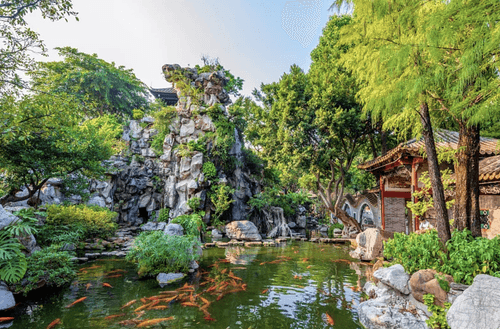
A Peaceful Retreat to the Lingnan Charm: Discovering Shunde Qinghui Garden
A Peaceful Retreat to the Lingnan Charm: Discovering Shunde Qinghui Garden
Hello, fellow travelers! Have you ever dreamt of stepping into a calm, elegant world that whispers tales of ancient China? Today, I want to take you on a journey to a very special place in Shunde, which is part of Foshan in Guangdong Province, China. It’s called Qinghui Garden (清晖园), and trust me, it’s a hidden gem that will capture your heart.
Forget the hustle and bustle for a moment. Qinghui Garden isn't just a park; it's a beautifully preserved piece of history, a canvas of art, and a vibrant echo of a unique regional culture.
Whispers of the Past: The History of Qinghui Garden
Every old garden has a story, and Qinghui Garden's is quite fascinating. The history of Qinghui Garden stretches back to the Ming Dynasty (1368–1644). It originally started as the residence of the famous scholar Huang Shijun (黄士俊), who was a top-ranking scholar in the Imperial Examinations.
However, the garden we see today largely took shape during the Qing Dynasty (1644–1912), particularly during the reign of Emperor Jiaqing (1796–1820). The later owner, Long Yingshi (龙应时), and his family spent generations expanding and refining it, transforming the property into the exquisite private garden we admire today.
The name "Qinghui" itself is elegant, meaning "Clear Radiance." It suggests a bright, peaceful, and scholarly atmosphere. It truly reflects the cultured background of the families who nurtured it. Walking through its winding paths, you're literally walking through centuries of history, seeing the architectural and artistic tastes of old Lingnan scholars unfold before your eyes.
An Artistic Masterpiece: The Essence of Lingnan Garden
Qinghui Garden holds a very significant place in Chinese garden history. It is recognized as one of the 4 famous Chinese gardens in Southern China (also known as the Four Great Gardens of Guangdong), alongside Yu Yin Garden in Panyu, Ke Garden in Dongguan, and Liang Garden in Foshan.
These gardens, collectively known as Lingnan Garden, have a distinct style compared to the more famous classical gardens in the wetter "Jiangnan" region (like Suzhou). Lingnan refers to the area south of the Five Ranges, an area known for its warm, humid climate and rich folk culture.
What makes the Lingnan Garden style, and Qinghui Garden specifically, so unique?
Intricate Structure in a Small Space: Lingnan gardens are often compact, cleverly using walls, winding corridors, and "borrowed scenery" (where features outside the garden walls are incorporated into the view) to make the space feel much larger. Qinghui Garden is a maze of charming walkways, small bridges, and pavilions, creating a "garden within a garden" effect.
A Blend of East and West: Because Guangdong (Canton) was a hub for foreign trade, the garden's artistry shows fascinating influences. You’ll find traditional Chinese carvings and paintings right next to colored glass windows imported from Europe during the Qing Dynasty. This mix of Ming-Qing Chinese culture with subtle Western elements is a signature of Lingnan art.
Focus on Local Materials and Climate: To cope with the warm, rainy climate, the architecture is designed to be open and airy. You'll see beautiful, detailed brick carvings, pottery sculptures (Shiwan artistic ceramics), and wood carvings on the gates and windows, often depicting local flora and fauna. The water features are also a highlight, connecting different areas with canals and ponds, bringing a sense of coolness and tranquility.
A Tour of Scenery: The Landscapes You Can't Miss
Qinghui Garden is a visual delight, a place where every corner is a perfect photo opportunity. Here are a few spots and elements to look out for:
The Boat Hall (船厅): This is one of the most famous and unique features. It’s a waterside pavilion built to look like a traditional Chinese boat, complete with 'deck' and 'cabin'. Sitting inside, you feel as if you are gently floating on the water, a clever artistic illusion.
Bixi Cottage (碧溪草堂): This main building is beautifully preserved and shows the high level of craftsmanship. Look up at the roof for the exquisite ceramic figures and decorations.
Dou Dong (斗洞): A fantastic example of "rock as mountain." The artificial rockery is skillfully constructed to mimic natural caves and mountains, adding drama and depth to the landscape.
The Bridges and Waterways: The garden’s various small bridges and streams are essential to its tranquility. They connect the different "rooms" of the garden, guiding you on a peaceful, winding journey. The water is often home to vibrant koi fish, adding splashes of color.
Greenery and Flora: The subtropical climate allows for lush greenery. You’ll see ancient banyan trees, bamboo groves, and various bonsai (potted plants art), all meticulously maintained to enhance the garden's poetic atmosphere.
Cultural Heartbeat: More Than Just a View
Qinghui Garden is more than pretty scenery; it’s a living museum of local Lingnan culture.
Scholarly Spirit: The garden was designed as a place for the gentry and scholars to read, write poetry, paint, and meditate. You can still feel that scholarly, refined atmosphere in the names of the pavilions and studies (like the "Xiyin Study" - 惜阴书屋, meaning "Cherish the light of time").
Traditional Arts: Pay close attention to the details. The garden is rich in cultural elements:
Wood and Brick Carvings: These carvings often depict popular folktales, historical events, or auspicious symbols, serving as visual narratives of Chinese tradition
Calligraphy and Couplets: Elegant scripts written by famous scholars are engraved on stone tablets or displayed on plaques, adding literary depth.
The Shunde Connection: Shunde is globally famous as the "Cradle of Cantonese Cuisine." A visit here is a chance to connect the visual beauty of the garden with the culinary artistry of the city. The garden is a perfect reflection of the refined lifestyle and appreciation for beauty that characterizes the Shunde people.
Practical Guide: Planning Your Visit
Ready to step into this ancient world? Here's what you need to know about visiting Qinghui Garden:
Location: The garden is conveniently located in the center of Shunde District, Foshan City. Its full address is No. 23 Qinghui Road, Daliang Street, Shunde District, Foshan, Guangdong.
Getting There: If you're coming from Guangzhou, it’s easily accessible by subway and taxi. Take the Foshan Metro Line 3 to Daliang Zhonglou Station (大良钟楼站), and it’s a short walk from there.
What is the ticket for Qinghui Garden? The entry ticket for Qinghui Garden is very reasonably priced. The standard admission is RMB 15 (subject to change, so always double-check locally or online). Certain groups, like Shunde residents, young children, and seniors over 65, may be eligible for free or discounted entry.
Best Time to Visit: To avoid the biggest crowds, try to go on a weekday morning. The garden is open from 9:00 AM to 5:30 PM (with the last entry at 5:00 PM).
What to Do:
Take it Slow: The garden is not huge, but it's dense with details. Allow at least 1.5 to 2 hours to wander slowly.
Find the Free Tour: The garden often offers free guided commentary tours at set times throughout the day (usually in Mandarin, but check for availability of English audio guides or English tour times). A guide can unlock many of the historical and cultural secrets you might otherwise miss.
Enjoy the Light: The morning light filtering through the colorful glass windows or the afternoon sun on the water can be truly magical.
Conclusion
Qinghui Garden is a peaceful, poetic escape. It’s a place where the grandeur of history, the elegance of art, and the unique spirit of Lingnan Garden architecture come together in perfect harmony. It might not be as internationally famous as some others, but its humble, detailed beauty is exactly what makes it so special.
So, when you visit China, take a detour to Shunde. Step through the gates of Qinghui Garden, let the clear radiance (Qinghui) wash over you, and leave feeling refreshed, cultured, and inspired. It’s a little piece of authentic Southern China waiting just for you!
Happy Traveling!


